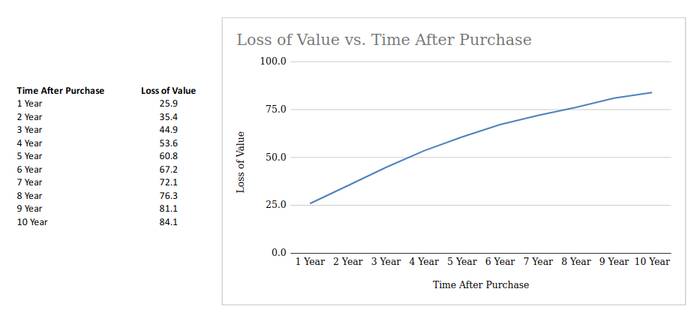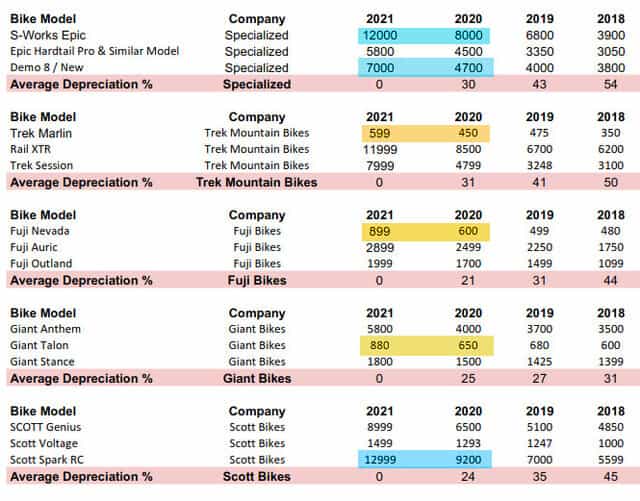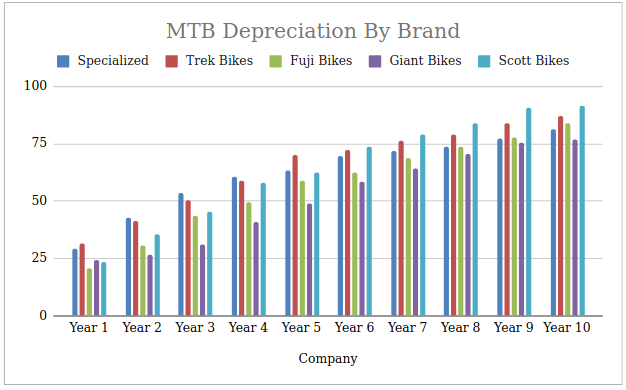Mountain bikes tend to lean on the more expensive side because of their durability both on and off sidewalks or set bike paths. Spending a few hundred dollars is not out of the question, but with equipment like mountain bikes you tend to get what you paid for.
In present times, with inflation impacting all areas of our life, the mountain bike industry has not been spared. If you’re in the market for a mountain bike, you will be surprised to know the price range of these bikes.
Depending on how often you use your mountain bike and how well you maintain it your bike will lose its value. Initial retain cost and depreciation cost have a direct co-relation, when one increases, the other follows.
Unfortunately, as you set out on your mountain biking adventure, the value of your bike begins to reduce. If you are interested in delving deep into what depreciation means for your bike, you’ve come to the right place.
This article is sure to give you evidence-based information right from the yearly depreciation of your bike to the factors that determine the value of your mountain bike.
Let’s Start With The Conclusion

Conclusion #1: You Loose Money On Your Bike The Instant You Ride It Off The Shop.
While the actual depreciation on mountain bikes varies with brand and type, on average you loose 26% of its original worth the instant you ride it off the shop.
In our independent research mountain bikes tends to loose between 24 to 31 % in its value in 1 year followed by 35% loss in its value by another year.
Thus losing a significant 25% in the first year and then 10% in the next year. From the above-mentioned data, you can see the value of your bike will keep on decreasing from the time of purchase.
So buying a new mountain bike especially above $1000 never makes much sense. As you can loose $200 on your $1499 mountain bike by the time it reach your home.
To be clear, I do not necessarily find it foolish to buy new mountain bikes. In fact, I had bought the majority of my bikes brand new from stores and online. All I ask to not buy one just for financial reasons.

Conclusion #2: Expensive Mountain Bike Loose Their Value Faster Than Cheaper Ones
While you may need to pay a premium to get the latest in mountain biking, it is usually them who lose their value faster than generic mountain bikes in the low and mid-price range.
They might be fun to ride in short to mid range they do not hold their value well in long term as the technology used become radially available at cheaper price across the brands.
From my own research on used mountain bikes, I find premium mountain bikes lose their value from $12999 to $8000 in 1 year while mid-range bikes lose from $5800 to $4000 at the same time.
With cheaper mountain bikes in between the $800 and $1500 range, the value lost in the first year is even lower with depreciation as low as 18% in comparison with 40% for most expensive bikes.
Conclusion #3: Bikes From Some Brands Holds Their value Better Than Others
Like all mountain bikes don’t hold their value same mountain bikes of different brands lose their value differently. In my analysis of data gathered from sales of 80 odd mountain bikes, depreciation on a mountain bike is closely tied to the brand and year rather than its overall quality.
While I had gone through many sales data but the brands that stand out with the most sales figures were Specialized, Trek, Giant, Fuji, and Scott brands respectively.
As you can see from the data, Trek and Specialized bike depreciate more in the first year. Brands such as Giant, Fuji and Scott depreciate by 21% on average than 30% for trek and specialized mountain bikes.
While some brands depreciate slower than others they all depreciate much or less the same by end of 5 years. As Scott bike that depreciate slower in first 3 years depreciate faster later on even surpassing trek and specialized bike by the end of 10 years.
Conclusion #4: The Best Spot To Buy Used Mountain Bikes Is Between 1-3 Years
There is no doubt on the fact that mountain bikes loose their value as they age. Even our own research suggest the same even with greater details with solid numbers to back.
As we see from the data a new mountain bike loses about 26% of its original worth by 1 year it’s often the best time to buy them for a great band for your buck.
At 1 years age its used but new like and mostly don not have any issues. Thus buying a mountain bike that old gives you a great return on investment. As the longer you wait the more will be wear and tear, so until its more than 3 years old the price you pay is worth for the bike you get.
Remember, the longer you wait the worse the condition of bike you get. There will always be issues regarding one and another parts requiring frequent maintenance that cost money.
In case you wait too long till the price drop as much as 80% of the original price. Not you will be troubled by the bike condition but also find it hard when finding original parts replacement.
Without argument I will prefer to buy 1-2 year old mountain bike when bike one for myself!
How Much Do Mountain Bikes Depreciate Per Year?
We are all well-aware of the gradual sky-rocketing prices of mountain bikes in the market. What is important to understand is that as the retail price rises, so does the cost of depreciation.
There is sure to be a loss in the value of your mountain bike depending on how old it is. Let’s say you bought your mountain bike just last year, the loss in value will surprisingly be 25.9%.
This is the minimum loss you will face, as when the bike is older, the loss increases by leaps and bounds. If the bike is two and three years old, the value of it will depreciate by 35.4% and 44.9% respectively.
If you are looking to sell your bike in its fourth year, it is likely to lose its value by a whopping 53.6%. However, as your mountain bike turns five, you will notice that the depreciation value decreases at a diminishing rate.
After five years of purchase, the value of the bike is sure to reduce by 60.8% and after six years, 67.2%. If you wait another year or two, the value is sure to go down by an additional 5% and 9% respectively.
Waiting for nine years will cost you a hefty sum at 81.1%. If you decide to wait 10 years for the resale of your bike, you will face a huge loss as compared to what you originally paid for it.
At 10 years, the bike will see an 84.1% loss in value and be worth only about 16% of its original value.
It is essential to note that the depreciation value of your bike does not depend only on how old it is. The condition of the bike is also as important when it comes to its resale value.
What’s Your Bike Worth? Get True Price For Your Mountain Bike
If you’re in the market for a new mountain bike, you probably wish to sell your old one to collect the funds for our new purchase. Or, on the other hand, you may have an old mountain bike in your garage and may want to sell it. To do either of these, you will first need to know how much your bike is worth.
When calculating the worth of your bike, there are a number of factors you will have to take into account. It is essential to get the amount your bike is worth and not be taken for a ride when it comes to resale value.
It is also not wise to sell your bike for more than it is worth, as the buyer is quite likely to have all the information they need while making the purchase.
For instance, the brand of your mountain bike plays a huge role in determining its worth. Anyone in the market for a new one is well-versed about the best brands in the market and all their benefits.
If your bike is of a top-notch brand, its worth is sure to be much higher than a mountain bike that is as old and in the same condition as yours but of a brand that sits in the lower rungs of the industry.
The brand also speaks volumes of the features the bike has to offer and so plays an integral role in determining its worth. As bikes from some brands hold their value better than others.
What Affects Your Mountain Bike Value?
As we saw above, determining the worth of your mountain bike is integral to its resale value. Let’s not take a look at the factors that impact the value of your mountain bike.
Brand & Technology
We are already aware of the importance the name of the brand holds when laying a finger on the value of your bike. However, the technology of the bike is also an important aspect.
As technology is constantly changing and upgrading, if your bike is a relatively newer model, its value is likely to be high. This is a rather subjective matter though, as technology changes rapidly and no matter what the features of your bike are, the value largely depends on other bikes in the market and the latest technology.
Material & Quality
Additionally, the material of the frame of the mountain bike also plays a role in depreciation.
For instance, if the body of your bike is made of Titanium, it is likely to be more durable, and hence, get you a better resale price. High-quality steel and carbon are also sure to get you a good price, but the price will definitely deteriorate if the body comprises low-budget aluminum or steel.
Since you’re an avid riding, you know how important the wheels of the bike are. If your bike has wheels of supreme quality, it will definitely fetch you a great price.
The working performance of the bike parts should also be exceptional, so the rider can have a seamless experience, regardless of the terrain.
Maintenance, Use & Age
Sometimes the bike price also changes based on its prior use and how it was stored/maintained. If the last owner maintains the bike well and was not used much; the resale value went up by a margin.
That’s why you might find some odd ones that not fell well into our average depreciation chart. We too find but ignored them as they constitute less than 2% of all the sales. Last, but surely not least, the suspension of the bike makes for the feel of it while riding on winding roads or narrow paths.
All these factors are sure to impact the value of your mountain bike. One may think that the age of the bike is the most important aspect that affects its value. However, the above-mentioned factors are essential.
What are Factors that Help MTB Hold their Value?
There are hundreds of different mountain bike manufactures out there. While their intent is the same not all brands and types are created equal.
One of the biggest ways you can help your mountain bike retain its value is by purchasing a bike from a highly coveted brand. Bikes made by top brands are all-around better than departmental store bikes.
Where you store your bike plays a huge factor in depreciation.
While mountain bikes are designed to handle rough terrain and normal rainfall, leaving them out during storms, extremely cold weather, or in snow can start to wear down on parts of your bike.
The faster parts begin to wear, tear or break the lesser value your bike will have.
Taking good care of your bike while it’s not in use by protecting it from harsh weather will help keep the value by ensuring you won’t have to replace parts earlier than their usual lifespan.
When you begin to repair a bike earlier than usual it depreciates the value faster, and the bike will no longer have its original parts which is a big factor regarding reselling value.
Maintaining your bike after rides is important, too. Cleaning your bike thoroughly after each run regardless of whether it looks dirty or not will help all the parts in working order.
Deep cleaning means finding any small rocks or pebbles stuck in places they shouldn’t be and stops them from causing further damage on your next ride.
Regularly checking shocks, tires, and chains will give you an idea of how much rough handling your bike can really take. Say after a really hard ride down a rocky mountain your rear shocks are in worse shape than usual; it’s better you know the limits and use your bike accordingly.
Now you know that extremely rocky terrain does a harder number on your bike than average mountain trails and you can take care of your bike accordingly if harder rides are going to become a regular occurrence.
Is Buying Old Mountain Bikes Still a Good Choice?
Buying any used piece of equipment always comes with a risk but there are ways to minimize that risk especially when it comes to mountain bikes.
First, know what size and style you’re looking for. What kind of suspension? Do you want any added features? Knowing specifics will enable you to narrow down your search a lot.
In the world of mountain bikes, there are dozens of sizes and shapes to choose from, having details is going to save you a lot of time during your search.
Old mountain bikes are still a great option if you’re just starting out. Getting into the groove of mountain biking is going to take awhile because it is so vastly different than casual on the road or sidewalk bikes.
A less used bike that already has worn in shocks and tires would benefit a new rider. You won’t have to deal with the initial stiffness and getting the bike and yourself used to off-roading at the same time.
It can be a comfort knowing that the bike you’re looking at can handle the terrains you plan on taking it through, too. No playing the guessing game of what’s going to be too tough on the bike.
Tips for Used Mountain Bikes Buyer
Do thorough research about prospective sellers before anything else. There are some people who make it a hobby to fix up old bikes and sell them which is a great way to upcycle.
But the internet has given people the ability to leave public reviews. If you can see if the seller has any reviews on their products before inspecting further.
Ask about the history of the bike. What type of terrain was it used on the majority of its life? Are all the parts original? Any accidents? Any frame damage? Knicks or scratches?
The more details you get about the bike the better-rounded idea you’ll have about the condition.
It may look new and well taken care of but there are internal issues that can arise and cost you money in the long run like shot suspension.
If the seller is being withholding that could be a sign that the bike is more used than advertised.
Test it out. Think of it as buying a used car. You want to drive it, see how it feels and get a sense of how it’s going to operate. With mountain bikes you need to get a frame that is right for your body size.
Testing it out is another way to check how the suspension feels and judge the overall quality. When buying make sure to buy a bike that can handle the amount of use you’re wanting to squeeze out of it.
Mountain bikes do depreciate over time but a well-taken care bike can live a long happy life alongside you.
Good brands and good owners make a huge difference in mountain bike lifespan. Used or new, do your research first and foremost!
Also Read,
15 Best Mountain Bike Brand in 2023 – Bicycle Guide










Leave a Reply